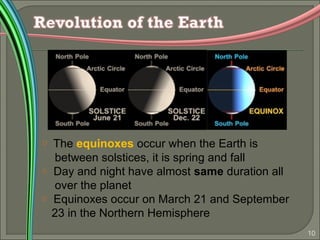The Earth in Space
- 2. o The earth rotates about an imaginary line that passes through the North and South Poles of the planet. This line is called the axis of rotation. 2
- 3. o It is for this reason, that it seems that the sun: вҖў Rises in the East вҖў Is south at noon вҖў Sets in the West o This axis is tilted o The rotation occurs from west to east over a 24-hour period o
- 4. o This rotation causes the cycle of day and night o Since Earth is round and opaque, the sun can only illuminate one side at a time o This is why when it is daytime in America, it is night in Australia 4
- 5. o The Earth also turns around the sun in a path called an ORBIT at a speed of 29.75km/s o It takes 365.25 days for one complete revolution (a solar year) o Every 4 years the extra day is added to the calendar as February 29, this type of year is called a LEAP YEAR. 5
- 6. o Because the EarthвҖҷs axis is tilted, our planet is in different positions during the year, giving us 4 different seasons 6
- 7. oThe seasons are marked by solstices and equinoxes вҖ” astronomical terms that relate to EarthвҖҷs tilt. oThe solstices mark the points at which the poles are tilted at their maximum toward or away from the sun. 7
- 8. o Summer solstice o shortest night of the year o sun is farthest north o first day of summer oJune 21 in Northern hemisphere 8
- 9. o Winter solstice o longest night of the year o Sun is farthest south o first day of winter o December 21 in Northern hemisphere 9
- 10. o The equinoxes occur when the Earth is between solstices, it is spring and fall o Day and night have almost same duration all over the planet o Equinoxes occur on March 21 and September 23 in the Northern Hemisphere 10
- 11. o At the equator, the sunlight hits the EarthвҖҷs surface at a 90Лҡ angle, which results in a more concentrated amount of sun in a given area. o At the poles, the same amount of sun is shining but not at a 90Лҡ angle. oThe rays therefore get spread out over a larger area, making the sun less strong over any given area. 11
- 12. Credits Jessica Montreal, QC











